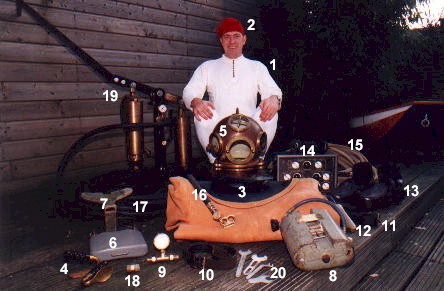
The diver, ready to get dressed and descend

Introduction
A remark before we start: some viewers ask us the difference between Draeger and Dräger. Answer: there is no difference. The equipment all comes from the same factory. It has something to do with German spelling. In Germen the combination "ae" was used for the sound of the English "a". Later, the "ae" was replaced with "ä". Thus, on older equipment (untill the nineteenthirties) you will find Draeger. On younger equipment Dräger.
1 Underwear
Woolen underwear protects the diver against the cold water. In extreme cold water, several layers can be worn.
2 Cap
A red woolen cap is worn by many divers. Do you want to know why? During decompression stops the diver rests his head against the cold copper inside of the helmet. The cap gives a little comfort. Do you want to know why it is red? The diver works in rough environments like harbors. Many colors there are metal, rusty or brown. When he sits on a bench to eat his lunch between dives, he will still be dressed in his suit and the corselet. By wearing a red cap other guys working in the harbor (like them sitting high in a crane for instance!) will notice there is someone there. Thus, the red cap is worn for safety and comfort (bet you did not know that…)
3 Suit
Dates from 1959 and is made of Indiana rubber. The big pro on Dräger suits is that you will have an absolute watertight connection. It also has a disadvantage: the diver has to enter the suit through the small neck opening. This can take up to 4 tenders to help! We placed a dry suit zip in the back of the suit to prevent ripping the valuable collar.
4 Cuff expanders
Made of brass and used to help the diver stick his wrists through the narrow rubber cuffs. Another method that is often used is a soap solution. This works very good as well but the solution affects the rubber. After the dive the rubber has to be cleaned VERY thoroughly and powdered with talcon.
5 Helmet
Draeger 3 bolt air helmet number 1283, is from around 1915. Helmets up to number 1050 had a "Bubikopf". This type of helmet has a round shaped neck.
6 Back weight
Worn on the back. Made of cast iron and weighs 16 kilograms. Attached to the corselet with two special hooks.
7 Sitting weight
Worn between the legs. Made of cast iron and weighs 6 kilograms. A Draeger invention. This way the diver can use lighter shoes. As a second advantage, the diver can easily work under water while sitting on his weight.
8 Air chest weight
Worn on the chest. Made of cast iron and weighs 19 kilograms. Attached to the corselet with two special hooks. A Draeger invention. The weight contains two 1 liter tanks that contain together a total of 400 liters of compressed air when filled up to 200 atm/bar. These tanks are connected to the helmet by a flexible hose. In case of an emergency, the diver will have enough air to reach the surface. It can also be helpful during fast descends or when the diver has to pick up heavy materials underwater. It can then give him positive buoyancy.
9 Pressure gauge
Gauge and connection needed to refill the air chest weight tanks from a main compressed air tank.
10 Crutch belt
Leather belt used to connect the back weight to the air chest weight through the sitting weight.
11 Waist belt
Leather belt used to hold the divers knife and to connect the safety line and the helmet hose.
12 Knife
A diver should never go down without his knife. It is made of tough steel and carried in a brass steath. The term knife is in fact misleading. It is an instrument used for prying, hacking, sawing, or cutting such material as wood, wire, rope and sheet metal. In this case you see a Russian saw knife number 1239 of 1500.
13 Shoes
Made of cast iron and weigh 5.5 kilograms each. They are lighter than the regular standard diving shoes because of the sitting weight assembly, invented by Dräger. They are more like sandals and easy to get in and out.
14 Radio
In this case a radio for two divers. Two tenders are able to communicate with 2 divers. But the two divers can also speak to each other.
15 Communication wire
The communication wire is integrated in the safety line. It is 50 meters / 150 feet long. One end is attached to the divers belt and the helmet, the other end is attached to the divers radio. The material is extremely strong. The line can be used to pull a diver up to the surface in case of an emergency.
16 Helmet Hose
A separate piece of air hose with a length of about 1 meter / 3.3 feet is used to connect the helmet to the divers waist belt. The actual air hose is connected to the helmet hose and not directly to the helmet. You find this same feature on Mark V equipment.
17 Air hose
The air hose has a length of 15 meters / 45 feet. It has brass female couplings at both ends.
18 Coupling
Air hoses are connected together by a double male brass coupling. On Dräger air hoses no washers are used.
19 Air pump
A two cylinder lever pump is used for air supply. A lever pump can only be used up to 30 meters / 90 feet of depth due to its limited capacity. With 15 strokes it will supply about 45 liters of air per minute at the surface.
20 Tools
A small set of tools is needed for connecting the hoses to each other and to the pump and to tighten the bolts on the helmet. A special spanner is needed to disassemble the exhaust valve.